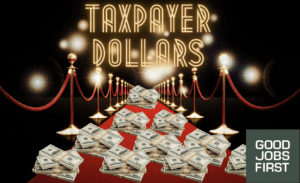
It’s Oscars season, and once again we’ll see stars walk the red carpet. With tears and toothy smiles, the winners will thank the directors and producers, their moms, and best friends. Missing from the thank yous will inevitably be one to us — for helping pay for so many of their films to be made.
In recent years, film subsidies have grown exponentially. Proponents claim that film tax credits film tax credits pay for themselves because they attract industry activity to the state, but research from academics, economists, and state auditors suggests otherwise. It was because of research showing their ineffectiveness — some studies revealed film subsidies returned taxpayers as little as a dime on their $1 investment — that states began eliminating or reducing Hollywood giveaways. That trend reversed in recent years.
Film tax credits, with their refundable or transferable nature, essentially translate to cash gifts covering a percentage of the filming budget. This leads to “rent-seeking,” where Hollywood producers and consultants seek incentives, playing states against each other while promising to create a thriving in-state entertainment economy.
With the Oscars on the horizon, we’re reviewing Academy Award-nominated films we found to have received subsidies.
It’s not a complete list. Transparency remains an issue when it comes to film subsidies, with some states, like Massachusetts, lagging in disclosure and others, like New Mexico and Georgia (which gives away over $1 billion per year), providing no disclosure at all.
We know “The Holdovers” got tax credits in Massachusetts (the director said as much in an interview), but we won’t know how much for about two years due to the state’s delayed reporting.
Here’s the breakdown of known subsidies for Best Picture films nominated between 2013-22:
- 2013 – Argo received $6.4 million through the California Film and Television Production Tax Credit Program.
- 2014 – 12 Years a Slave received two subsidies of $511,800 and $4.9 million through Louisiana’s Motion Picture Tax Credit Program.
- 2015 – Birdman was filmed in New York before the recipients of the state’s film tax credit were publicly disclosed.
- 2016 – Spotlight received $435,151 through the Massachusetts Film Tax Incentive Program.
- 2017 – Moonlight was filmed in Florida, which recently retired its film subsidy program but had poor reporting previously.
- 2018 – The Shape of Water was filmed in Canada, which offers a 25% incentive for labor associated with production.
- 2019 – Green Book received $5.8 million through the Louisiana Motion Picture Tax Credit Program.
- 2020 – Parasite was filmed in South Korea, which has a 20-25% cash rebate for production.
- 2021 – Nomadland was filmed in South Dakota, Nevada, Arizona, and Nebraska— all states which have poor film subsidy transparency.
- 2022 – CODA received $2.2 million through the Massachusetts Film Tax Incentive Program.
- 2023 – Everything Everywhere All at Once was filmed in California, with any subsidies not yet disclosed.
Note: Subsidy dollar amounts for productions filmed outside the U.S. were not calculated.
In a previous blog on subsidies to Oscar nominees from 2022, we highlighted the challenge of determining subsidies to the film CODA (2021). When we finally learned the total, we could see it was equivalent to the state’s budget for Elder Affairs that year.
As we celebrate our favorite movies, let’s not forget that, when it comes to film subsidies, the real losers are not the casts and producers who miss out on an Oscar but the taxpayers footing the bill for subsidies that fail to help boost state economies.
Read more of our Oscars coverage:
- Sunshine Week: TV Shows Get Public Subsidies Too. Here’s What We Know about Them. Or Not.
- And The Oscar Goes To: Public Subsidies. The 2022 edition
- And the Oscar Award for Best Actor Goes To … Film Subsidies for Their Portrayal of “Being a Good Investment”
- And The Oscar Goes To: State Subsidies for Oscar Nominated Movies